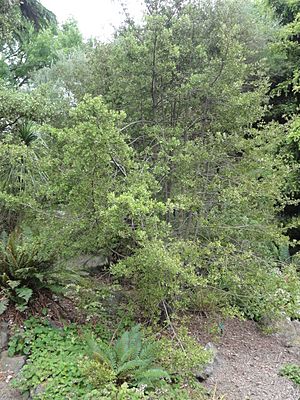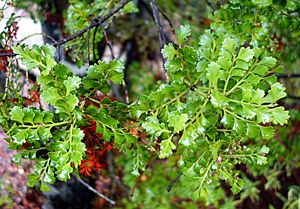Celery pines facts for kids
Quick facts for kids Celery pines |
|
|---|---|
 |
|
| Phyllocladus alpinus | |
| Scientific classification |
|
| Kingdom: | Plantae |
| Clade: | Tracheophytes |
| Division: | Pinophyta |
| Class: | Pinopsida |
| Order: | Pinales |
| Family: | Podocarpaceae |
| Genus: | Phyllocladus Rich. ex Mirb. |
| Species | |
|
Five; see text |
|
Phyllocladus, also known as celery pines, is a small group of conifer trees. These trees are usually considered part of the Podocarpaceae family. You can find them mostly in New Zealand, Tasmania, and Malesia (a region in Southeast Asia and Oceania) in the Southern Hemisphere. One type, P. hypophyllus, even grows north of the equator in the Philippines.
Contents
What are Celery Pines Like?
Celery pines are small to medium-sized trees, usually growing 10 to 30 meters (about 33 to 98 feet) tall. Sometimes, they can also be small shrubs. Their main branches start green for a few years, then turn brown as their bark gets thicker.
The actual leaves of these trees are tiny, like scales, only about 2 to 3 millimeters long. They are green for a short time, then turn brown. Most of the photosynthesis (the process where plants make their own food) happens in special, modified leaf-like shoots called phylloclades. These phylloclades grow where the tiny scale leaves are.
Phylloclades can be simple or complex:
- Simple phylloclades are shaped like a diamond, about 2 to 5 centimeters (about 1 to 2 inches) long.
- Complex phylloclades can be up to 20 centimeters (about 8 inches) long. They are divided into smaller, leaflet-like phylloclades, each 1 to 3 centimeters long.
The seed cones of celery pines look like berries. They are similar to the cones of other trees in the Podocarpaceae family. These cones have a soft, white, fleshy part called an aril. Birds eat this fleshy aril and then help spread the hard seeds in their droppings.
How Scientists Classify Them
Phyllocladus trees look quite different from other trees in the Podocarpaceae family. Because of this, some scientists used to think they should be in their own separate family called Phyllocladaceae.
However, recent studies looking at the DNA of these plants show that Phyllocladus actually belongs inside the Podocarpaceae family. Scientists now agree that the unique phylloclades are a special feature that helps identify this group of trees.
The five different types of Phyllocladus are genetically unique. They likely developed into separate species between 5 and 7 million years ago.
Types of Celery Pines
- Phyllocladus alpinus - known as mountain toatoa (found in New Zealand)
- Phyllocladus aspleniifolius - known as celery-top pine (found in Tasmania)
- Phyllocladus hypophyllus - known as Malesian celery-pine (found from New Guinea to Borneo and the Philippines)
- Phyllocladus toatoa - known as toatoa (found in New Zealand)
- Phyllocladus trichomanoides - known as tanekaha (found in New Zealand)
See also
 In Spanish: Phyllocladus para niños
In Spanish: Phyllocladus para niños
Images for kids
-
Phylloclades of P. trichomanoides
-
A seedling of P. aspleniifolius with needle-like juvenile leaves






